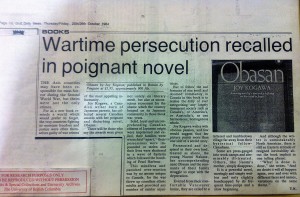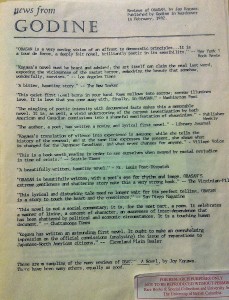Fond of Fonds: Obasan as a Technology of Memory
Hello readers!
I hope you are all well and enjoying the final moments of November. With December slowly creeping up on us, we must embrace the closing of term one in our first year at The University of British Columbia; this means more of the usual: final exams and papers!
Further, our ASTU class has been busy reading a heavyweight novel in Obasan by Joy Kogawa. Last week, we took a trip to Irving K. Barber Learning Center, where we visited the Rare Books and Special Collections to look at the Kogawa Fond. What made this field trip so unique was the mere fact that she donated a great amount of Obasan solely to UBC: drafts, rejection letters, reviews, letters from readers, newspaper articles, and so much more. During my time there, I was able to analyze and examine multiple letters, drafts, scribbles, newspapers, and reviews, some of which I have attached. In extending the scholarly conversation, this blog post will revolve around the impact Kogawa’s book as a technology of memory has had both on a personal and national level.
Since first published in 1981, Obasan has captured the hearts of people far and wide. As “the first novel in North America to tackle the subject of Japanese-Canadian internment directly” (Toten ix), this novel has been a prominent pioneer in exposing Canada’s darkest moments, but also a central figure in healing broken bridges.
As a major player in Canadian history, the political significance reaches insofar as catching the eyes of the press, Mulroney’s promise of reparation in 1984, to playing a role in the 1988 Redress Settlement Agreement. As a sharp voice in contrast to the silence expressed in the novel – “there is a silence that cannot speak. There is a silence that will not speak” (ix) – Obasan has been recognized and won great prestigious awards such as: 1981 Books in Canada First Novel Award, the Canadian Author’s Association 1982 Book of the Year Award, and reprinted in paperback by Penguin Books in 1983. From newspaper headlines entitled “A Japanese-Canadian’s emotional, haunting novel of life in a detention camp” and “Wartime persecution recalled in poignant novel”, these speak great volumes the furthering narrative of Obasan as a technology of memory; although this novel was published in 1981, it continues to impact people to present day.
On a personal level and having the honor of growing up in British Columbia, I am in accord with Teresa Toten, who has the role of introducing Obasan, says:
Not in Canada. No way. It could not have happened here.
Who would have guessed. Through the negation of memory and forgetting from the perspective of Obasan and the Japanese internment, a multicultural Canada has definitely done a job in suppressing the truths behind its dark side. A part of me understands the process of holding a particular image to the world, but I think there should be a certain extend of remembering. As seen in this organized, strategic forgetting, novels like Obasan provide striking questions as to why our government chooses to shy away from the Japanese internment, but highlight the Chinese head tax and Residential Schools. Personally, if it was not for reading Kogawa’s book, many Canadian’s including myself would not have been provided insight into an event that happened right in my backyard! I believe it is absolutely vital that transparency is a central figure, but to what extent must we forgive and forget is another question. On a national and personal level, we need to take time to remember all of the hardships and pains people living in Canada have gone through to end up so multicultural; we definitely did not get to the point we are now without the cries of thousands of Canadians and learning from our mistakes.
Why has the school education system shied away from a particular moment in their history? Does the government holding certain parts of its history benefit the greater good or is it important to be transparent of all?
This discussion is Obasan working as a dynamic technology of memory.
Cheers,
Nico Jimenez


